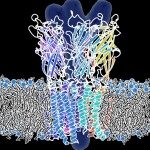Link to Pubmed [PMID] – 23442919
Link to HAL – Click here
Link to DOI – 10.1016/j.bpj.2012.12.037
Biophys. J. 2013 Feb;104(3):683-93
Amyloid proteins aggregate into polymorphic fibrils that damage tissues of the brain, nerves, and heart. Experimental and computational studies have examined the structural basis and the nucleation of short fibrils, but the ability to predict and precisely quantify the stability of larger aggregates has remained elusive. We established a complete classification of fibril shapes and developed a tool called CreateFibril to build such complex, polymorphic, modular structures automatically. We applied stability landscapes, a technique we developed to reveal reliable fibril structural parameters, to assess fibril stability. CreateFibril constructed HET-s, Aβ, and amylin fibrils up to 17 nm in length, and utilized a novel dipolar solvent model that captured the effect of dipole-dipole interactions between water and very large molecular systems to assess their aqueous stability. Our results validate experimental data for HET-s and Aβ, and suggest novel (to our knowledge) findings for amylin. In particular, we predicted the correct structural parameters (rotation angles, packing distances, hydrogen bond lengths, and helical pitches) for the one and three predominant HET-s protofilaments. We reveal and structurally characterize all known Aβ polymorphic fibrils, including structures recently classified as wrapped fibrils. Finally, we elucidate the predominant amylin fibrils and assert that native amylin is more stable than its amyloid form. CreateFibril and a database of all stable polymorphic fibril models we tested, along with their structural energy landscapes, are available at http://amyloid.cs.mcgill.ca.

